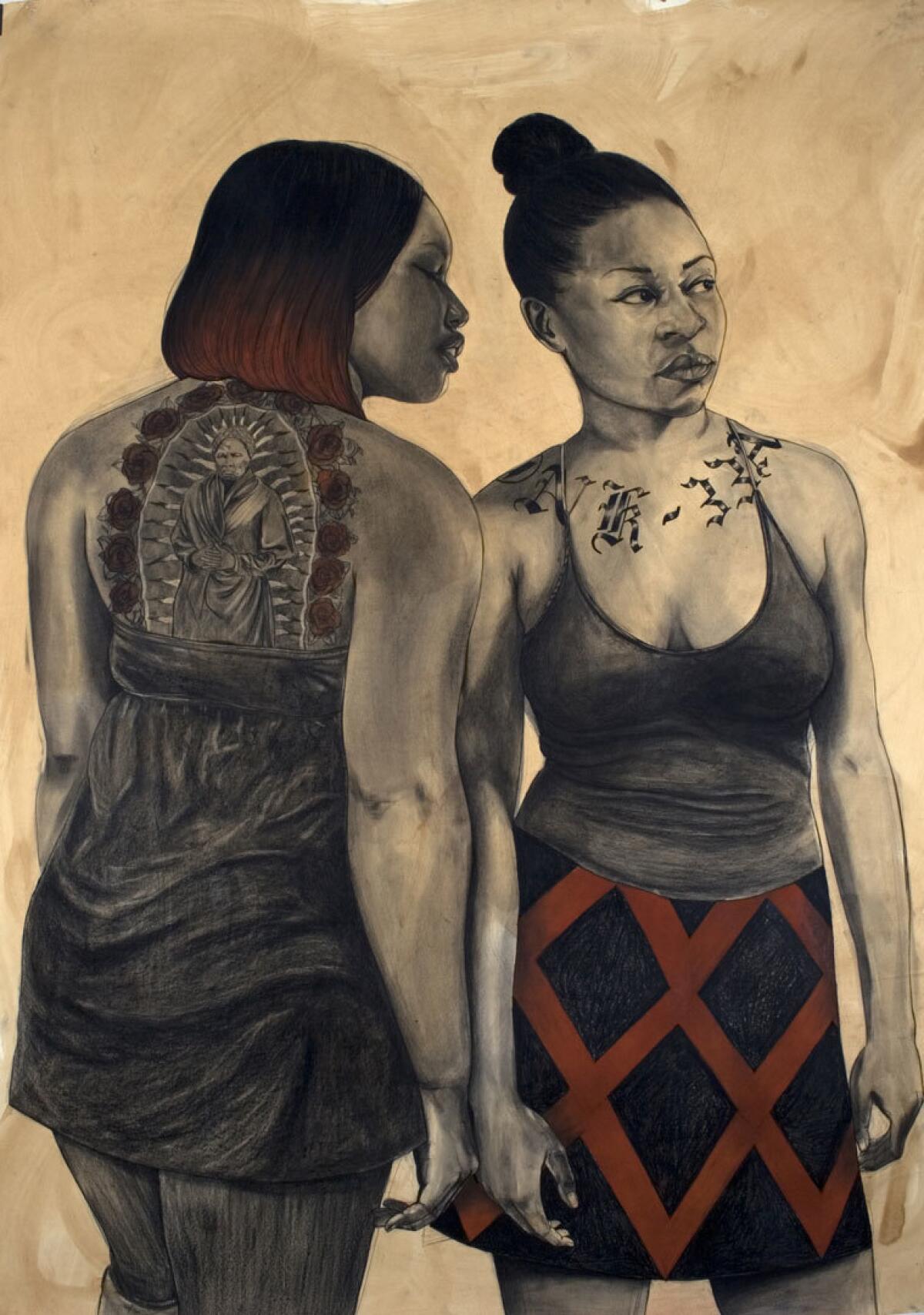Review: African American identity, front and center, in Robert Pruitt’s first major L.A. museum show
- Share via
The drawing by Robert Pruitt is searing: A young person does a little night reading on the couch that serves as a bed. A sheet, described only in sinuous lines, cascades down the sofa's back and rises again to sheathe the young reader’s limbs.
Head, one foot and one arm are the only parts uncovered, and Pruitt draws them with exquisite veracity. The hand holds a comic book, fingers touching a giant brick-red hand on the upturned page. A task light clipped resourcefully to the young person’s hair casts a blue light upon the face, where features are pursed in reckoning. The expression seems like some kind of private realization. A call has been heard.
It’s not certain whether "I Turned Myself Into Myself" — a drawing in charcoal, conté and pastel on paper that’s part of a tremendous exhibition at the California African American Museum in Los Angeles — is a self-portrait of Pruitt from an earlier time. The artist, born in Houston and now based in New York, makes comics and animations, in addition to drawings and sculpture that he says derive from "fictional ethnography."
Whether or not "I Turned Myself Into Myself" refers to a turning point of his own, the drawing’s physical presence and emotional intensity are breathtaking. At 60 by 84 inches, the scene is larger than life-size; affixed to the wall unframed (like all of his works on paper here), it has untempered immediacy. Identity is evolving and empowerment happening right there on the page.

In 10 other recent portraits in what’s billed as the artist's first major L.A. museum show, self-possession radiates from each character. There's a modern-day Adam and Eve, and an usher board president, a young man in a Basquiat T-shirt and a young woman with a Harriet Tubman tattoo.
Their insignia of dress and adornment link them to biblical narratives and cultural heroes. Some are visibly infused with the Afrofuturist aspiration to occupy another, better reality. Although Pruitt draws each to be palpably human, he also endows them with the monumentality of deities. The show is titled "Devotion," and part of that tender awe feels directed to these ordinary gods in our midst.

The show also pays tribute to Pruitt's influences, including Charles White and John Biggers, with representative works of theirs from the museum collection added to the mix. Rhymes and resonances abound between Pruitt's drawings and sculptures and between his work and that of the others. A poem about human and cosmic potential writes itself through the proximity of several of his own pieces: a drawing of our planet floating in vast blackness; a basketball turned holy relic by way of its aluminum foil gilding; a baseball hat lined in gold leaf, heavenly dome to the earthly body.
And that blue gleam of becoming on the young face in "I Turned Myself Into Myself"? It feels like a nod of devotion to the Yoruba headdress only a few feet away, its wooden skin delicately notched in repeating triangles and tinted a pale, celestial blue.
California African American Museum, Exposition Park, Figueroa Street and Exposition Boulevard (parking at West 39th Street and Figuroa). Through Feb. 17; closed Mondays, although open with special programming on the Martin Luther King Jr. Day holiday. (213) 744-7432, caamuseum.org
See all of our latest arts news and reviews at latimes.com/arts.
The biggest entertainment stories
Get our big stories about Hollywood, film, television, music, arts, culture and more right in your inbox as soon as they publish.
You may occasionally receive promotional content from the Los Angeles Times.






